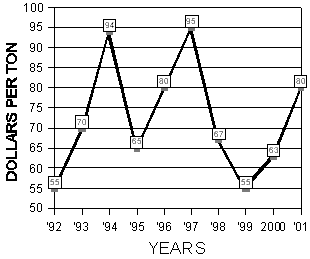Yuma County, Arizona
August 13, 2001
Yuma County Office
2200 W. 28th Street, Ste. 102
Yuma, AZ 85364
(520) 726-3904
(520) 726-8472 FAX
Production Update:
PDF version, 14KB
Summer Slump: is well-known by alfalfa growers as the
decrease in yields that normally occurs each summer in Arizona. Yield
decline with later harvests in the season occurs in most alfalfa-growing
regions of the world. Factors responsible for summer decline may include
temperature, day length, water stress, aging, and depletion of food reserves
in the plant. The rate of maturation of the crop is probably a primary
factor responsible for summer decline. In other words, the crop produces
a seed head so fast that time is not available to accumulate yields similar
to the spring. Summer slump can not be avoided in Arizona, but maintaining
adequate soil moisture levels can slow yield decline. Also, increasing
the cutting interval for one harvest during the late summer is recommended
to promote the health of the stand during this stressful time of year.
Insect Management:Witches'-broom disease has only been
of minor importance in the western United States, but is now present in
some low desert alfalfa fields. The disease was long considered to be
a leafhopper-transmitted virus, but now is known to be caused by a mycoplasmalike
microorganism. A vector of alfalfa witches'-broom disease in the western
United States is a leafhopper, Scaphytopius acutus. It is not known
if this leaf hopper or another leaf hopper is responsible for the current
disease symptoms. Symptoms of the disease include excessive development
of short, spindly shoots from the crown and axillary buds along the stem.
Spraying to control vector of the disease is out of the question at this
time as the epidemiology of the disease has not been studied in the low
desert.
Weed Control: EPTAM and Balan are the only herbicides
registered for preplant use in alfalfa. Both can reduce seedling numbers
and slow stand establishment. These are the only options, however, for
growers wanting to keep weeds from coming up with seedling alfalfa.
| Market Summary |
|
|
|
|
| Past 2 Weeks ( July 30 to August12, 2001) |
|
|
|
|
| Last Year (July 30 to August 12, 2000) |
|
|
|
|

Issued in furtherance of Cooperative Extension work, acts of May 8 and June 30, 1914, in cooperation with the U.S. Department of Agriculture, James A. Christenson, Director Cooperative Extension, College of Agriculture and Life Sciences, The University of Arizona.
The University of Arizona is an equal opportunity, affirmative action institution. The University does not discriminate on the basis of race, color, religion, sex, national origin, age, disability, veteran status, or sexual orientation in its programs and activities.
Any products, services, or organizations that are
mentioned, shown, or indirectly implied in this web document do not imply
endorsement by The University of Arizona.
Information provided by:
Barry Tickes, btickes@ag.arizona.edu Extension Agent, Yuma County
Michael Ottman, mottman@ag.arizona.edu Agronomy Specialist
College of Agriculture, The University of Arizona.
Eric Natwick, etnatwick@ucdavis.edu UCCE Imperial County - Farm Advisor
University of California, Davis, CA.
Material written August 13, 2001.
Forages: Crop Mgmt | Soil Mgmt | Irrigation | Alfalfa Reports | Insects | Diseases | Weeds | Pesticides
Home | Other Crops | Forages
For more Arizona Production Ag Information:
Home | Cotton | Veggies| Forages | Grains | Citrus | Crop x Crop | Insects | Diseases| Weeds | Pesticides | News | Weather | Research | Photos | Contacts | General Info. | Site Map
Copyright © 2001 University of Arizona,
College of Agriculture and Life Sciences
Webmaster: Al Fournier (fournier@ag.arizona.edu)